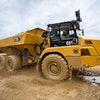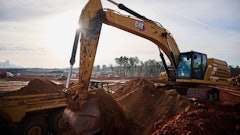Check out the video of our first look at the Doosan DD100 right here:
We recently got a preview of an important new Doosan machine—one that represents a market entry for the company.
Waiting for us nestled between giant mounds of dirt in at the Roc—Doosan’s big sandbox in the middle of the Tucson desert—was the DD100.

The DD100 is a 10-ton dozer, placing this machine at the top end of the small dozer category and squarely in competition with models like the Cat D3, Deere 650K and Case 850M.
Doosan decided to go with a 10-ton machine as its first dozer because the company's research says that the 10- to 15-ton size class represents about 50 percent of the total dozer market. So, starting there allows Doosan to reach a huge chunk of customers and renters with just one or two machine releases.
Speaking of which, the DD100 isn’t the only Doosan dozer in the works. Doosan is also working on a 130-horsepower, 13-ton dozer that it plans on launching in 2023.
Now, I mentioned earlier that this was an early look at the DD100. A sneak peek if you will.
That’s because the DD100 you see here isn’t just a prototype, it’s a pre-prototype machine. That means this is the first working DD100 Doosan has built and before it goes into production, Doosan will incorporate more customer and dealer feedback into another prototype, followed finally by a pilot machine and production.
So, as you’d expect, there are lots of rough edges on this machine and some of what we’re going to talk about may chance between now and the machine’s planned release in the third quarter of 2022.
A Strong First Step

When the DD100 launches, Doosan is aiming for it to be a best-in-class machine on a few fronts. But the company’s guiding principal with this machine was a desire to make a dozer that could scale to any operator’s skill level.
And the company’s engineering team had a pretty healthy head start in the design phase. That’s because a dozer was actually in the plans as far back as the Daewoo Heavy days. Even before the sale to Doosan, the Daewoo folks were working on a dozer that Doosan engineers were able to pull a lot from in designing the platform at the heart of the DD100.
The dozer is powered by the 3.4-liter Doosan D34 engine providing 122 horsepower. That tops the Cat D3 and Deere 650K’s 104 hp; the 105 hp on Komatsu’s D39 models, and the 112 hp on Case’s 850M.
Doosan has also designed the DD100 to be heavier than the competition, with the standard model weighing in at 22,000 pounds, while the low ground pressure configuration is 25,000 pounds.
Drawbar pull comes in at 33,721 pound-feet on the DD100 and Doosan says the dozer’s added horsepower and heavier weight will give it more tractive effort than the competition.
Visibility at Core of DD100's Design

Beyond power, Doosan said its engineering team has put a lot of effort into delivering a high degree of visibility from the cab of the DD100 as well.
The dozer features all glass doors and thin pillars giving you a full view of your working environment and excellent sight lines to the material you’re moving.
Another design feature of this dozer you’ll notice if you stare at the hood long enough is that there’s no pre-cleaner sitting up there. That’s because Doosan didn’t want a big old mushroom blocking the view provided by that sloped hood design, so they just got rid of it.
Well, not entirely. The DD100 still has a pre cleaner, but it’s an inline design. The only other 10-ton dozer with an inline pre-cleaner is the Cat D3.
Rounding out the visibility features on this dozer is the standard rear-review camera.
Ease of Use, Commonality of Controls
Moving to the front of the machine, a 2.9-cubic yard, 6-way variable angle pitch blade is standard. The LGP configuration has a 3.4-cubic-yard VPAT. Pitch on these blades is adjustable from 54-58 degrees and allows for six-way hydraulic adjustments and two-way mechanical adjustment.
Two Rexroth hydraulic pumps provide flow to the blade and Doosan has opted to make electro-hydraulic controls standard on the DD100.
Those E/H controls allow operators to tune the machine to their desired feel. Experienced operators can tune the machine for finer control. But if a less experienced operator is at the controls, they’ll have the ability to slow things down if need be.

Another aspect of this dozer geared toward easy operation is the optional parallel ripper design. This ripper maintains a constant angle of attack to the ground regardless of height.
Knowing that this machine will be part of Doosan rental fleets, Doosan wanted to ensure some control commonality between it and other machines. The DD100’s joysticks are the same ones you’ll find on its excavators.
Rounding out controls, Doosan is partnering with Trimble to bring optional massless 3D machine control to the DD100 as well.
Maintenance and Undercarriage
In terms of maintenance, the 3.4-liter D34 doesn’t have a diesel particulate filter, so that’s one less thing you’ll have to worry about. Daily check points are all easily accessible from the ground and Doosan has also opted for a tilting cab design for easy access to everything else.
But the aspect of the DD100 that Doosan feels is its biggest competitive edge is the undercarriage thanks to its sealed design and low total cost of ownership.
As of right now, two track widths will be offered: 20 inches on the standard configuration and a 27.5 inch width on the low ground pressure configuration. The undercarriage design places 7 feet, 7 inches of track on the ground.
You’ll notice that the shoes are a single grouser design, but Doosan says that it is considering offering a double grouser design on the production model, based on feedback it has received from customers and dealers.




















